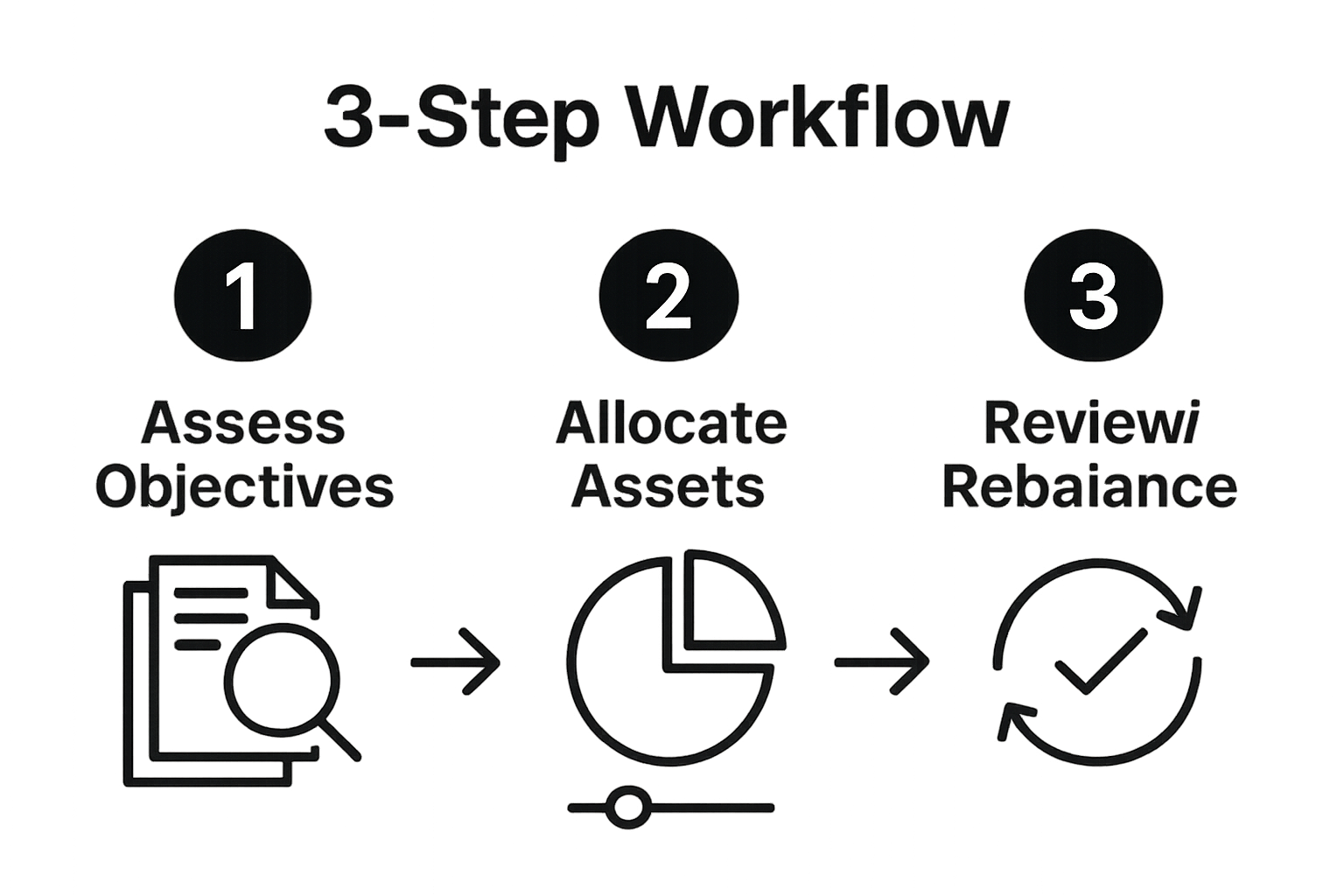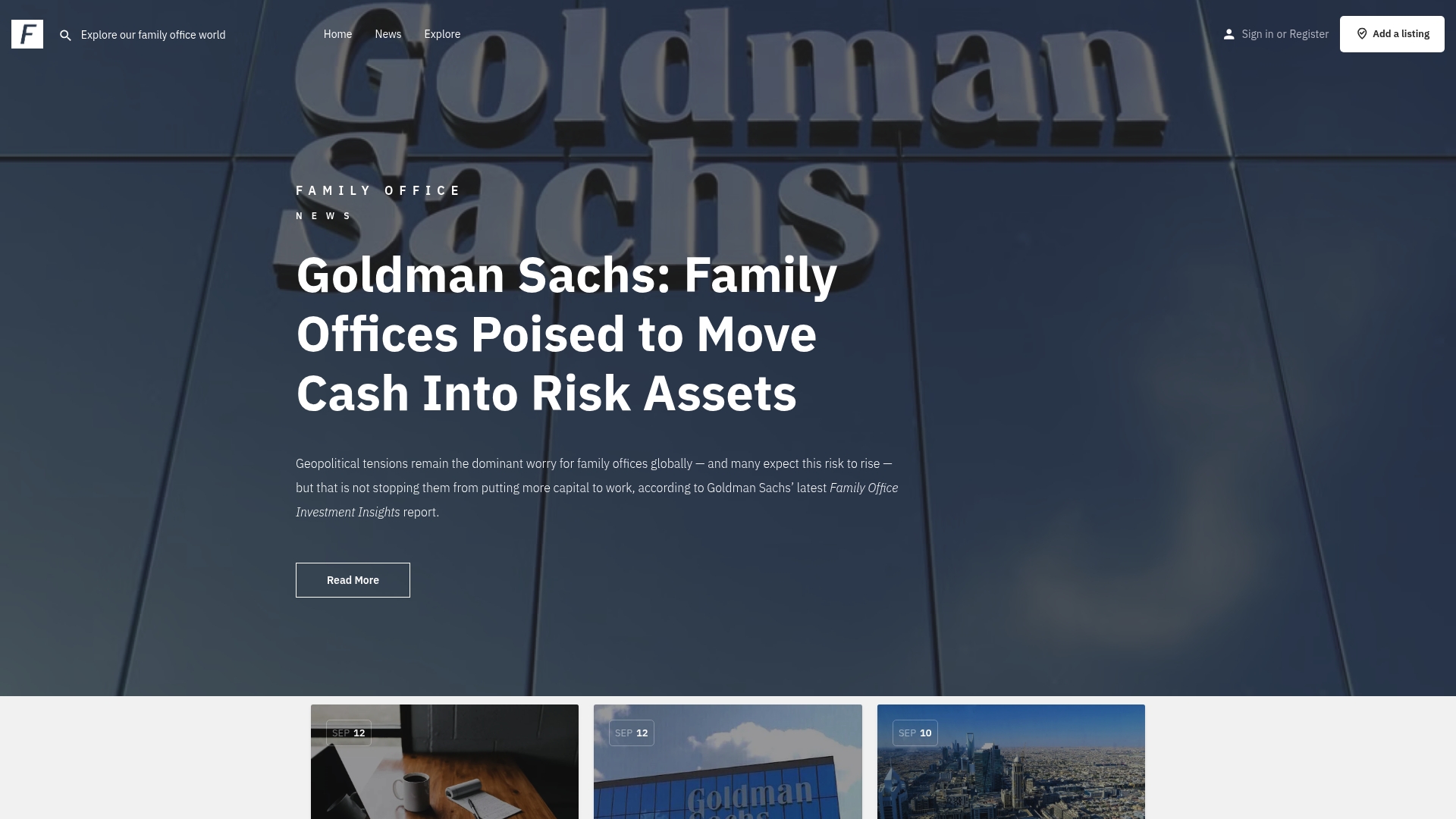Family offices manage astonishing sums, with some portfolios reaching into the billions of dollars across dozens of complex asset classes. Most people assume these teams just pick great investments and watch the money grow. The surprise is that real success depends far more on process than picking stocks. The secret is an organized workflow behind the scenes that quietly drives performance, protects generational wealth, and adapts as markets and family priorities shift.
Table of Contents
- Step 1: Assess Current Investment Objectives And Strategy
- Step 2: Develop A Comprehensive Asset Allocation Plan
- Step 3: Implement Due Diligence Processes For Selection
- Step 4: Execute Investment Transactions And Strategies
- Step 5: Monitor Performance And Adjust Investment Focus
- Step 6: Review And Refine Investment Workflow Regularly
Quick Summary
| Key Point | Explanation |
|---|---|
| 1. Assess Investment Objectives and Strategy | Regularly evaluate your goals and strategies to ensure alignment with financial resources. |
| 2. Develop Asset Allocation Plan | Strategically distribute capital across various asset classes to manage risk and returns effectively. |
| 3. Implement Robust Due Diligence | Establish a comprehensive evaluation framework to thoroughly assess potential investments and their risks. |
| 4. Execute Transactions with Precision | Create clear guidelines and utilize technology for efficient and strategic investment execution. |
| 5. Monitor Performance and Adjust Regularly | Continuously track investment performance and adjust strategies based on market conditions and family goals. |
Step 1: Assess Current Investment Objectives and Strategy
Successfully optimizing your family office investment workflow begins with a comprehensive assessment of your current investment objectives and strategy. This critical first step serves as the foundational blueprint for your entire investment approach, enabling you to align your financial resources with your long term wealth management goals.
Start by conducting a thorough internal review of your existing investment portfolio. Examine your current asset allocation, historical performance metrics, and risk tolerance levels. This means carefully analyzing each investment across different asset classes such as equities, fixed income, real estate, private equity, and alternative investments. Understand not just the performance numbers, but the underlying rationale behind each investment decision.
Your assessment should include a detailed mapping of your financial goals. Are you focused on wealth preservation, aggressive growth, generational wealth transfer, or a balanced approach? Each objective requires a distinct strategic framework. For ultra high net worth families, this often means creating a multifaceted investment strategy that balances immediate financial needs with long term generational wealth planning.
Work closely with your financial advisors to develop a comprehensive investment policy statement (IPS). This document will articulate your investment philosophy, risk parameters, return expectations, liquidity requirements, and specific guidelines for investment selections. An effective IPS acts as a strategic roadmap, providing clear direction for your investment team and helping maintain discipline during market fluctuations.
Consider leveraging advanced financial analysis tools that can provide deeper insights into your current portfolio. These tools can help you:
- Conduct sophisticated risk assessments
- Analyze correlation between different asset classes
- Simulate potential market scenarios
- Identify potential concentration risks
Remember that a successful family office investment workflow requires continuous reassessment. Market conditions, family dynamics, and personal financial goals evolve constantly. Schedule regular review periods perhaps quarterly or semi annually to ensure your investment strategy remains aligned with your changing objectives.
To validate the effectiveness of this initial assessment, confirm you have:
- A clear, documented investment policy statement
- Comprehensive portfolio performance analysis
- Identified specific investment objectives
- Mapped out risk tolerance levels
- Established a regular review mechanism
By meticulously completing this first step, you create a solid foundation for an efficient and responsive family office investment workflow that can adapt to changing financial landscapes and family needs.
Below is a checklist table to help verify that all critical components of your family office investment assessment have been completed for Step 1.
| Assessment Criteria | Description | Completion Status |
|---|---|---|
| Investment Policy Statement (IPS) | Documented principles, risk, returns, and guidelines | |
| Portfolio Performance Analysis | Comprehensive review of historical and current returns | |
| Investment Objectives Identified | Clear articulation of long- and short-term goals | |
| Risk Tolerance Mapped | Detailed analysis of risk capacity and appetite | |
| Regular Review Mechanism | Established and scheduled ongoing evaluation |
Step 2: Develop a Comprehensive Asset Allocation Plan
After thoroughly assessing your investment objectives, developing a comprehensive asset allocation plan becomes the critical next phase in your family office investment workflow. This strategic process transforms your initial assessment into a structured, mathematically precise investment approach that balances risk and potential returns across multiple asset classes.
Asset allocation is not about selecting individual investments, but about distributing your capital strategically across different investment categories. Your plan should reflect a nuanced understanding of how various asset classes interact, complementing each other to create a robust portfolio that can withstand market volatilities.
Begin by segmenting your investment capital across core asset categories: equities, fixed income, real estate, private equity, commodities, and alternative investments. The precise allocation percentages will depend on your risk tolerance, investment horizon, and specific family wealth objectives.
 For ultra high net worth families, this often means creating a more complex allocation strategy that goes beyond traditional stock and bond models.
For ultra high net worth families, this often means creating a more complex allocation strategy that goes beyond traditional stock and bond models.
According to modern portfolio theory research, diversification is key to managing investment risk. This means intentionally spreading investments across uncorrelated or minimally correlated assets. Your allocation should aim to construct a portfolio where potential losses in one asset class can be offset by gains or stability in another.
Consider implementing a dynamic allocation approach that allows periodic rebalancing. Markets evolve, and your allocation strategy must remain flexible. This might involve:
- Establishing target allocation ranges for each asset class
- Creating predetermined triggers for rebalancing
- Developing a systematic review process
- Maintaining liquidity buffers
Technology can significantly enhance your allocation planning. Advanced portfolio management software can provide sophisticated modeling, helping you simulate different allocation scenarios and understand potential outcomes under various market conditions. These tools can help you stress test your strategy, revealing potential vulnerabilities before they become real world risks.
To verify the effectiveness of your asset allocation plan, confirm you have:
- Clearly defined allocation percentages across asset classes
- Documented rationale for each allocation decision
- Established rebalancing protocols
- Created a framework for ongoing monitoring and adjustment
Remember that a well constructed asset allocation plan is not a static document, but a living strategy that evolves with your family’s changing financial landscape and broader economic conditions.

Step 3: Implement Due Diligence Processes for Selection
Implementing robust due diligence processes represents a critical juncture in your family office investment workflow, transforming potential opportunities into well vetted, strategically aligned investments. This step goes beyond surface level analysis, requiring a comprehensive and systematic approach to evaluating potential investment opportunities across different asset classes.
Due diligence is not a singular event but a multi layered investigative process that demands meticulous examination of potential investments from financial, operational, legal, and strategic perspectives. Your goal is to uncover not just apparent value, but potential risks and hidden complexities that could impact long term investment performance.
Begin by establishing a standardized due diligence framework that can be consistently applied across different investment types. This means creating a structured evaluation template that addresses key assessment criteria such as financial performance, management quality, market positioning, competitive landscape, regulatory compliance, and potential growth trajectories. For private equity or alternative investments, this process becomes even more nuanced, requiring deeper forensic analysis.
Leverage technology and specialized tools to enhance your due diligence capabilities. Advanced data analytics platforms can provide deep insights, aggregating information from multiple sources to create comprehensive investment profiles. These tools can help you:
- Conduct rapid financial analysis
- Perform background checks on key management personnel
- Assess regulatory and compliance risks
- Compare potential investments against industry benchmarks
According to investment research methodology, comprehensive due diligence should incorporate both quantitative and qualitative assessment methods. This means going beyond financial statements to understand the strategic vision, organizational culture, and potential future challenges of potential investment targets.
Establish a multi tier review process that involves different levels of expertise within your family office. This might include initial screening by junior analysts, followed by detailed reviews by senior investment professionals, and final validation by an investment committee. Each tier should have specific evaluation criteria and the authority to recommend advancement or rejection of an investment opportunity.
Use the table below to compare the main features and focus areas of due diligence for different investment types as discussed in Step 3.
| Investment Type | Key Due Diligence Focus Areas |
|---|---|
| Public Equities | Financial performance, market positioning, management quality |
| Fixed Income | Credit ratings, interest rate risk, issuer stability |
| Real Estate | Property valuation, location analysis, regulatory compliance |
| Private Equity | Management team, growth potential, detailed forensic financial review |
| Alternative Assets | Strategy transparency, operational risk, competitive landscape |
To verify the effectiveness of your due diligence process, confirm you have:
- A standardized due diligence evaluation framework
- Clear documentation of assessment criteria
- Multiple expert review layers
- Comprehensive risk assessment documentation
- Systematic method for tracking and comparing potential investments
Remember that effective due diligence is not about eliminating all risks, but about understanding and managing potential challenges with informed, strategic decision making.
Step 4: Execute Investment Transactions and Strategies
Executing investment transactions and strategies represents the pivotal moment where your meticulously developed investment plan transforms from theoretical framework to actionable financial moves. This step demands precision, strategic timing, and a sophisticated approach to market engagement that goes beyond simple buying and selling.
Transaction execution is not merely a mechanical process, but a nuanced art of strategic financial positioning. Your approach must balance immediate investment objectives with long term portfolio goals, considering factors like market liquidity, transaction costs, potential tax implications, and overall portfolio balance.
Develop a comprehensive transaction management protocol that standardizes how investments are executed across different asset classes. This means creating clear guidelines for trade execution, including predetermined parameters for entry and exit points, maximum acceptable transaction sizes, and specific risk management triggers. For ultra high net worth family offices, this often involves a multi layered approval process that ensures each transaction aligns with the overarching investment strategy.
Leverage advanced technological platforms that provide real time market insights and execution capabilities. Modern investment technology offers sophisticated tools that can:
- Execute trades across multiple global exchanges simultaneously
- Provide granular price and liquidity analytics
- Implement complex trading strategies
- Monitor transaction performance in real time
According to institutional trading research, integrating automated trading mechanisms with human oversight can significantly improve execution quality. This means developing a hybrid approach where algorithmic trading tools are complemented by expert human judgment, ensuring both efficiency and strategic nuance.
Establish a rigorous post transaction review process that analyzes the performance and strategic alignment of each investment move. This involves documenting the rationale behind each transaction, tracking its performance against initial expectations, and using these insights to refine future investment strategies. Transparency and detailed record keeping are crucial for maintaining accountability and continuous improvement.
To verify the effectiveness of your transaction execution strategy, confirm you have:
- Documented transaction execution protocols
- Clear approval and review mechanisms
- Comprehensive transaction tracking systems
- Performance analysis frameworks
- Established feedback loops for strategy refinement
Remember that successful transaction execution is about more than just completing trades it is about strategic positioning that advances your family office’s broader financial objectives.
Step 5: Monitor Performance and Adjust Investment Focus
Monitoring performance and dynamically adjusting your investment focus represents the critical ongoing maintenance phase of your family office investment workflow. This step transforms your investment strategy from a static plan into a responsive, adaptive financial ecosystem that can navigate complex market landscapes.
Performance monitoring is not about obsessive daily tracking, but strategic periodic assessment that reveals deeper trends and potential strategic shifts. Your approach should balance granular data analysis with broader strategic perspectives, ensuring you can make informed decisions without becoming reactive to short term market fluctuations.
Develop a comprehensive performance measurement framework that goes beyond traditional return metrics. This means creating a multidimensional assessment approach that evaluates investments across various dimensions such as absolute returns, risk adjusted performance, correlation with broader market trends, alignment with original investment objectives, and potential future growth trajectories.
Leverage advanced performance analytics platforms that can provide sophisticated insights. Modern investment technologies offer tools that can:
- Generate detailed performance visualization
- Conduct comparative analysis across asset classes
- Identify subtle performance trends
- Simulate potential future scenarios
- Provide predictive risk assessments
According to investment performance research, successful performance monitoring requires a holistic view that considers both quantitative metrics and qualitative factors. This means understanding not just financial numbers, but the strategic context behind investment performance.
Establish a dynamic reallocation protocol that allows systematic and strategic portfolio adjustments. This involves creating predefined triggers and thresholds that initiate portfolio rebalancing when specific performance or market conditions are met. Your reallocation strategy should be flexible enough to respond to changing market conditions while maintaining your core investment philosophy.
To verify the effectiveness of your performance monitoring approach, confirm you have:
- Comprehensive performance tracking mechanisms
- Clear performance evaluation criteria
- Established reallocation protocols
- Regular review and assessment schedules
- Documented decision making processes
Remember that effective performance monitoring is an ongoing dialogue between your investment strategy, market conditions, and evolving family wealth objectives. It requires patience, strategic thinking, and a willingness to make calculated adjustments when opportunities or risks emerge.
Step 6: Review and Refine Investment Workflow Regularly
Regular review and refinement of your investment workflow represents the final critical step in maintaining a dynamic, responsive family office investment strategy. This ongoing process ensures that your investment approach remains adaptive, aligned with changing market conditions, family objectives, and emerging financial technologies.
Workflow refinement is not about wholesale transformation, but incremental, strategic improvements that enhance overall investment performance. Your review process should create a continuous learning environment where each investment cycle provides insights that can be systematically integrated into future strategies.
Establish a structured periodic review mechanism that goes beyond traditional annual assessments. This means creating multiple layers of review with different frequencies and depths of analysis. Quarterly comprehensive reviews can examine broad strategic alignment, while monthly or even weekly tactical reviews can address more immediate operational aspects of your investment workflow.
Leverage technology and specialized workflow management platforms that can provide comprehensive insights into your investment processes. Advanced tools can help you:
- Track workflow efficiency metrics
- Identify potential bottlenecks
- Compare performance against predefined benchmarks
- Generate detailed process improvement recommendations
- Maintain comprehensive audit trails
According to organizational performance research, successful workflow refinement requires a systematic approach that balances standardization with flexibility. This means creating clear protocols while maintaining the agility to adapt quickly to changing circumstances.
Develop a formal knowledge management system that captures insights, lessons learned, and strategic decisions from each investment cycle. This institutional memory becomes a powerful resource, allowing your family office to build upon previous experiences and avoid repeating past mistakes. Documentation should be comprehensive yet concise, focusing on actionable insights rather than bureaucratic detail.
To verify the effectiveness of your workflow review process, confirm you have:
- Established regular review schedules
- Comprehensive documentation protocols
- Clear performance improvement mechanisms
- Systematic knowledge capture processes
- Flexible adaptation frameworks
Remember that the most successful family offices view workflow refinement not as a compliance exercise, but as a strategic opportunity for continuous improvement and innovation. Your investment workflow should be a living, breathing system that evolves alongside your family’s financial journey.
Take Control of Your Family Office Investment Process Today
Are you struggling to keep your family office investment workflow efficient and aligned with your unique wealth objectives? Many leaders face roadblocks like fragmented due diligence, unclear asset allocation, and a lack of transparency when monitoring performance. This article showed how critical it is to build a seamless workflow involving detailed risk assessment, dynamic rebalancing, and regular review cycles. But the reality is, achieving this level of organization and insight can be overwhelming without access to the right tools and industry connections.

Imagine having a single hub designed specifically for the global family office community. At Future Family Office, you get instant access to a rich directory of service providers, timely investment news, and thought leadership focused on your real challenges. Build your network, access tailored industry resources, and keep pace with fast-changing trends. Make your investment workflow smarter and more connected today. Visit Future Family Office now to start streamlining your process and engaging with peers who share your vision for growth and excellence.
Frequently Asked Questions
How can I assess my family office’s current investment objectives and strategy?
To assess your family office’s investment objectives and strategy, conduct a thorough internal review of your existing investment portfolio. Analyze asset allocation, historical performance metrics, and risk tolerance levels to align your financial resources with your long-term wealth goals.
What is an Investment Policy Statement (IPS), and why is it important?
An Investment Policy Statement (IPS) is a document that articulates your investment philosophy, risk parameters, return expectations, and liquidity requirements. It serves as a strategic roadmap for your investment team, ensuring discipline and clarity in decision-making during market fluctuations.
What should I include in a comprehensive asset allocation plan?
A comprehensive asset allocation plan should include core asset categories such as equities, fixed income, real estate, private equity, and alternative investments, along with clearly defined allocation percentages based on your risk tolerance and investment objectives.
How often should I review my investment strategy?
You should schedule regular review periods, ideally quarterly or semi-annually, to ensure that your investment strategy remains aligned with evolving market conditions, family dynamics, and personal financial goals.
Recommended
- When Cash Is Not King: The New Favorite Investment Options For Family Offices – Future Family Office
- 5 Family Offices Making Impact Investments – Future Family Office
- January 2020 Family Office Data Report – Future Family Office
- What Do Banks Believe Family Offices Should Focus On? – Future Family Office




